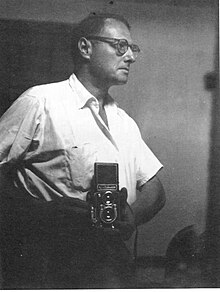Pierre Edouard Leopold Verger,aliasFatumbiorFátúmbí(4 November 1902, inParis– 11 February 1996, inSalvador,Brazil) was aphotographer,self-taughtethnographer,andbabalawo(Yorubapriest ofIfà) who devoted most of his life to the study of theAfricandiaspora — theslave trade,the African-based religions of the new world, and the resulting cultural and economical flows from and to Africa.[1]

Life
editAt the age of 30, after losing his family, Pierre Verger took up the career of journalistic photographer. Over the next 15 years, he traveled the four continents, documenting many civilizations that would soon be effaced by progress. His destinations included Tahiti (1933); United States, Japan, and China (1934 and 1937);Italy,Spain,Sudan (nowMali),Niger,Upper Volta,TogoandDahomey(nowBenin,1935); theWest Indies(1936); Mexico (1937, 1939, and 1957); thePhilippinesandIndochina(nowThailand,Laos,CambodiaandVietnam,1938);GuatemalaandEcuador(1939);Senegal(as a conscript, 1940);Argentina(1941),PeruandBolivia(1942 and 1946); and finallyBrazil(1946). His photographs were featured in magazines such asParis-Soir,Daily Mirror(under the pseudonym of "Mr. Lensman" ),Life,andParis Match,and in 1955 his graphic composition of three women bearing vases of flowers on turbaned heads was selected by curatorEdward Steichenfor MoMA's 1955 world-touringThe Family of Manexhibition, seen by 9 million visitors.[2]
In the city of Salvador, Brazil he fell in love with the place and people, and decided to stay for good. Having become interested in the local history and culture, he turned from errant photographer to a researcher of the African diaspora in the Americas. His subsequent voyages are focused on that goal: the west coast of Africa andParamaribo(1948),Haiti(1949), and Cuba (1957). After studying theYorubaculture and its influences inBrazil,Verger became an initiate of theCandombléreligion, and officiated at its rituals. During a visit toBenin,he was initiated intoIfá(ikindivination), became ababalawo(priest) ofOrunmila,and was renamedFátúmbí( "he who is reborn through the Ifá oracle" ).
Veger's contributions to ethnography are embodied in dozens of conference papers, journal articles and books,[3][4][5]and were recognized bySorbonne University,which conferred upon him a doctoral degree (Docteur 3eme Cycle) in 1966 — quite a feat for someone who dropped out of high school at 17.
Verger continued to study and document his chosen subject right until his death in Salvador, at the age of 93. During that time he became a professor at theFederal University of Bahiain 1973, where he was responsible for the establishment of theAfro-Brazilian Museumin Salvador; and served as visiting professor at theUniversity of IféinNigeria.The non-profitPierre Verger Foundationin Salvador, which he established to continue his work, holds more than 63,000 photos and negatives taken until 1973, as well as his papers and correspondence.
His life has been documented in a book by Jérôme Souty[6]and a movie.[7]
References
edit- ^Carole Cusack, Alex Norman Handbook of New Religions and Cultural Production 2012- Page 480 "... were the french anthropologists Pierre Verger (1902–1996) andRoger Bastide(1898–1974), who both turned out to be a kind of 'culture hero' for both Candomblé and the afro-brazilian people. "
- ^Steichen, Edward; Steichen, Edward, 1879-1973, (organizer.); Sandburg, Carl, 1878-1967, (writer of foreword.); Norman, Dorothy, 1905–1997, (writer of added text.); Lionni, Leo, 1910-1999, (book designer.); Mason, Jerry, (editor.); Stoller, Ezra, (photographer.); Museum of Modern Art (New York, N.Y.) (1955),The family of man: the photographic exhibition,Published for the Museum of Modern Art by Simon and Schuster in collaboration with the Maco Magazine Corporation
{{citation}}:|author6=has generic name (help)CS1 maint: multiple names: authors list (link) CS1 maint: numeric names: authors list (link) - ^ Pierre Verger (1951).Note sur le culte des orisha e vodoun à Bahia de Tous les Saints au Brésil et à l'ancienne Côte des Esclaves; republished in 1982 byCorrupio,Brazil.Memoire (in French). IFAN,Dakar,Senegal.
- ^ Pierre Verger (1985).Fluxo e Refluxo do tráfico de escravos entre o golfo de Benin e a Bahia de Todos os Santos(in Portuguese). Corrupio.
- ^
Pierre Verger (1995).Ewé, o uso de plantas na sociedade ioruba(in Portuguese). Translated by English, English Editor: Doig Simmonds. Odebrecht andCompanhia das Letras,Brazil.
{{cite book}}:|translator=has generic name (help) - ^ Jérôme Souty (2007).Pierre Fatumbi Verger. Du Regard Détaché à la Connaissance Initiatique(in French). Maisonneuve & Larose, Paris. p. 520.; Jérôme Souty (2011) (in Portuguese)Pierre Fatumbi Verger. Do Olhar livre ao conhecimento iniciatico,Terceiro Nome, São Paulo, 446 p.
- ^Pierre Fatumbi Verger:Mensageiro Entre Dois Mundos.Movie, Brazil (1998).
External links
edit- Dieux D'Afrique - prefaces(in French)
- Pierre Verger Foundation, Salvador(in Portuguese)
- Pierre Fatumbi Verger and his works(in Portuguese)
- Pierre Fatumbi Verger by Cida Nóbrega(in Portuguese)